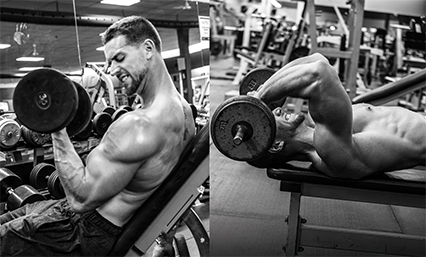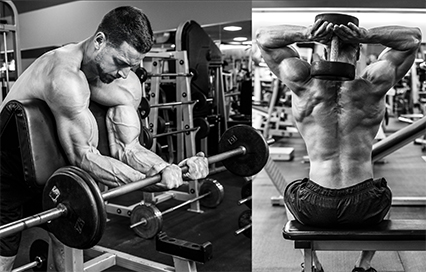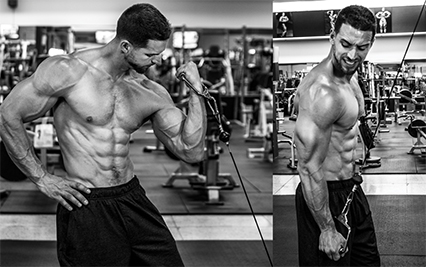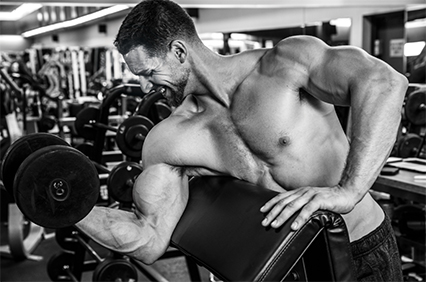Supersets For Forging Bigger Ams Fast!

How to use the advanced training priciple of supersetting for biceps and triceps growth in record time
Chances are when you first started training, biceps were your focus and curls were the exercise you attacked hardest and most often—even before you started asking, “How much ya bench?”
The arm flex is what almost everyone does if someone says, “make a muscle.” As time went by, your training became a bit more sophisticated and you added triceps work, understanding how much it contributes to the overall mass of the upper arm and pursuing the “horseshoe” look.
Regardless of what your training goals are, strong and healthy elbow flexors and extensors are important for performance, and really muscular arms look good on everyone. Surprisingly to me, a lot of trainees tell me they find arm work boring! Although at its most basic it’s flex/extend/repeat, to me, a good arm pump is well worth the effort. It’s instant positive feedback for your hard work!
One great way to reduce boredom and ensure a great pump is to incorporate antagonistic supersets using antagonist muscle groups, such as biceps/triceps or quads/hamstrings work, to provide limb movement in opposite directions. So performing a curl movement—elbow flexion—uses muscles performing antagonistically from those performing an elbow extension.
Doing a biceps movement followed immediately by a triceps movement (or the other way around) will not only speed your training up and get you moving but also really get the blood flowing. Keep those sleeves loose or you’ll be busting out of ‘em!
For the purposes of this article, we’ll be training biceps first; you’ll want to continue doing this for the duration of your program (six to 12 weeks, depending on your individual needs) and then reverse the order and change movements for your next training cycle.
Before starting the routine, perform a general warm-up and then a brief specific warm-up consisting of one to two lighter sets of your next exercise. Individual warm-up needs will vary, even from workout to workout, so adjust appropriately.

SUPERSET 1: Incline Dumbbell Curls/Skullcrushers
Incline Dumbbell Curls
Begin by setting the incline bench at about 70 to 80 degrees. A very low incline will make the movement difficult to perform and hard on the shoulders.
With your back against the pad and your scapula retracted and depressed (shoulders back and down) start with the dumbbells in a neutral position (palms facing in). Curl both dumbbells up simultaneously, keeping your elbows at your sides. As you curl the dumbbells up, supinate your wrist so your palms are facing up at the top of the movement. The biceps’ function is to assist in elbow flexion and forearm supination (palms turned up) and pronation (palm turned down), so this movement is a good start to the workout. Lower the dumbbells to the starting position under control and repeat. Upon completion of the set, immediately move to the next exercise.
Skullcrushers (Lying Barbell Extensions)
Ideally, you won’t actually crush your skull while performing these; choose your load appropriately. The somewhat intimidatingly named movement can be done with a straight bar or EZ-curl bar; the EZ-curl is often more comfortable on the wrist and is a more popular choice with most trainees.
Lie flat on a bench (a low incline can also be used) with a close, overhand grip on the bar. Lower the bar under control to the forehead or bridge of the nose. Extend the arms to return to the start position. Avoid allowing the elbows to excessively flare out to the side, and don’t lock the elbows completely to maintain tension on the triceps.

SUPERSET 2: Alternating Dumbbell Hammer Curl/Triceps Cable Press-Downs
Alternating Dumbbell Hammer Curls
The biceps aren’t the only muscle involved in elbow flexion. A substantial amount of flexion is actually produced by the brachialis. The brachialis, however, isn’t involved in pronation or supination of the wrist, so by keeping a neutral grip (thumbs up), this movement can focus on the brachialis. In addition to improving flexion strength, hammer curls improve upper arm appearance as the brachialis grows and “pushes” the biceps up.
Hammer curls may be performed standing or seated; excessive body swing should be avoided.
Begin by holding a dumbbell in the neutral position in each hand. Start with either arm. Curl up one dumbbell at a time, keeping your elbows at your side. Pause and squeeze for a second at the top, and lower under control; the grip remains neutral through the entire movement. Once the first rep is complete, complete the next rep with the opposite arm and repeat. Hammer curls can also be performed simultaneously.
Triceps Cable Press-Downs
Push-downs offer a lot of variety, beginning with grip—V-bar, straight bar, cambered (EZ-curl) bar, rope, and multiple varieties of bar/rope thickness as well. The straight bar or middle section of the EZ-curl bar will hit more of the lateral and long heads of the triceps.
Set the bar on a high cable with your grip inside shoulder width. Keeping your upper arms by your sides, use your triceps to extend your arms to full length, stopping just short of full lockout to maintain tension. Triceps often benefit from higher volume, so keep the reps higher and aim for a great pump here.

SUPERSET 3: Barbell Preacher Curls/Overhead Dumbbell Extensions
Barbell Preacher Curls
This is an absolute classic arm movement also known as “Scott curls” after inaugural Mr. Olympia Larry Scott, who had biceps that would have been epic in any era. They’re often a staple in the routines of bodybuilders worldwide. These, too, can be performed with an EZ-curl bar or straight barbell.
Your grip for preacher curls should be shoulder width. Taking too wide a grip can create elbow issues and will likely feel awkward. As the shoulders will be pushed forward (scapular protraction), head position is important—the chin should be tucked down a bit to maintain position of the cervical spine. Throwing the head back while performing preacher curls can put the cervical spine at risk.
Once in position, curl the bar up and squeeze the biceps at the top of the movement for a second, then lower under control to the starting point. Repeat for the prescribed reps.
Overhead Dumbbell Extensions
These can be performed seated or standing. Either way, ensure stability is maintained through the torso throughout the movement.
Begin by holding a single dumbbell overhead; place both hands under the plates on one side of the dumbbell so it’s perpendicular to the ground. Your palms will be flat against the plate with your thumbs around the handle. Lower the dumbbell under control behind the head, and then use the triceps to extend the arm back to the starting position. Avoid locking the elbow completely to maintain tension on the triceps.

SUPERSET 4: Single-Arm Cable Curls/Single-Arm Reverse-Grip Cable Pull-Downs
This is the perfect end to a good arm session, and although it may be simple, it’s anything but easy. Your reward? A pump that practically requires a sleeveless shirt, and the satisfaction of knowing you worked hard!
Single-Arm Cable Curls
Use a single D-handle set to the low position on an adjustable cable (this is important for the speed we want to use in getting to the second movement and then back again). Stand far enough back from the cable and make sure the handle is low enough that you have constant tension the whole way through the range of motion (you can also do this facing away from the stack, which will give you a different angle and shoulder position similar to the incline dumbbell curl). Curl the handle up to about chin level, squeeze the biceps hard at the top for a two count, then lower under control to the starting point.
Repeat for the required reps, then immediately switch to the opposite hand and repeat. Once complete, immediately move to the following exercise.
Single-Arm Reverse-Grip Cable Pull-Downs
Adjust the cable to a high position, using the same D-handle, with the same supinated (underhand) grip. Start with the handle near shoulder level (there should be tension on your triceps), extend your arm just shy of full lockout, squeeze the triceps for a two count and return to the starting position.
Complete the required reps and immediately switch to the opposite arm. Once the other arm is done, immediately adjust the cable back to the low position and repeat the cable curls for each arm, switching back to push-downs as soon as those sets are done.
There is zero rest between these sets—each individual muscle gets to rest while the antagonist and other arm is working. Sounds great, but it’s challenging if you follow the guidelines and select an appropriate load.
During this last superset, if/when you hit failure, switch right away to the other arm/antagonist muscle rather than dropping the weight to try and get all the reps out. Accumulated fatigue is the goal here, and as you get stronger, those reps will come.
BREAKING DOWN YOUR
SUPERSET ARM BLITZ!
Superset 1:
Incline Dumbbell Curls
4 sets of 8 reps, Rest Interval: 0
Skullcrushers
4 sets of 12 reps, Rest Interval: 60 seconds
Superset 2:
Alternating Dumbbell Hammer Curls
4 sets of 10 reps, Rest Interval: 0
Cable Push-Downs
4 sets of 15 reps, Rest Interval: 60 seconds
Superset 3:
Barbell Preacher Curls
4 sets of 12 reps, Rest Interval: 0
Overhead Dumbbell Extensions
4 sets of 12 reps, Rest Interval: 60 seconds
Superset 4:
One-Arm Cable Curls
4 sets of 15 reps, Rest Interval: 0
One-Arm Reverse-Grip Push-Downs
4 sets of 15 reps, Rest Interval: 60 seconds
Reps and Arm Supersets
You should not complete all the reps prescribed! You should hit failure at least once in each exercise. In other words, 4 × 10 should probably be 10, 10, 10, 8 or similar. In training, failure is the point at which you can no longer complete a rep with good form; you might be able to get another one by using some body momentum, but this isn’t accomplishing what you’re after—stimulating muscle growth. If you complete all 4 sets of 10, don’t stop at 10 on your last set. Keep going until you hit failure! If you wind up doing 20 reps, the weight was too light. The good news? Next time you get to go heavier!
Don’t Lose Your Tempo
A note on tempo: There are no specific tempos for this workout; however, all reps should be performed with good form and under control to ensure the target muscle is doing the work. The length of time for performing the concentric (positive or “up” motion) portion of the movement should be about the same as the eccentric (negative or “down”) along with a squeeze or contraction of the active muscle at the peak or top of the movement.
Click HERE to sign up for our free newsletter!


